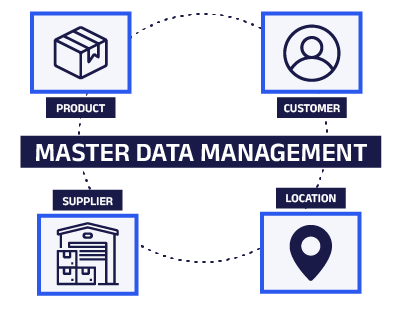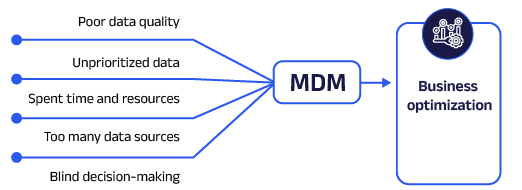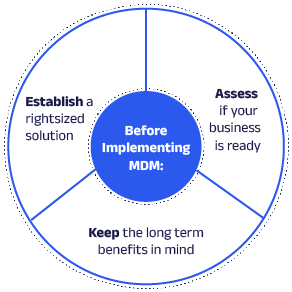5 clear signs to know if your business needs Data Management
Nowadays, companies around the world are becoming aware of the importance of migrating processes into a digital environment, including their master data management. Thanks to actual global business standards, acquiring technological tools is needed to face new challenges regarding large-scale IT management processes: instead of storing countless folders with difficult-to-handle data, there already are digital organizational methods that carry out an entire emptying of information in an automated way, which results in great advantages to stay ahead of competition.
We’re specifically talking about Master Data Management, also known as MDM.
Master Data Management is a process which allows managing and classifying an organization’s most relevant information through the discovery, cleaning, synchronization, unification and usability of Master Data. A good MDM implementation enables having a central repository of the most critical data under business rules, strategies, operations and politics. Data is usually scattered in different systems, leading to a bad information management: through the use of tools and special techniques, MDM takes on these issues.
According to Gartner, “many organizations are considering MDM as a solution, attracted by the promise of an enterprise wide trusted view of critical data '', thus becoming a strategic necessity for Data-driven businesses to keep on developing. In this article, we will talk about how important MDM is for companies who present certain signs of needed improvement and how to tackle these issues.

Master Data Management components
Signs to know if your business needs MDM
If you're wondering about the need to implement an MDM process in your business, here is some food for thought: data has become critical in terms of value for any company, regardless of the number of staff members, stakeholders, and locations. To put it simply: data has become a vital resource for any business to keep developing in this digital era. In this sense, let’s check what are some signs that indicate if there are any development opportunities, which tend to get resolved through the implementation of an MDM process. Do you think your organization has any of the following?
1. Poor data quality often impacts your business.
According to a Gartner survey, “organizations believe poor data quality costs them an average of $11.8 million”, which means this matter can be a burden to endure, not only on day-to-day activities, but also financially speaking.
If you usually have to deal with finding and using the correct information, it is a clear sign of poor data quality. But, what does this entail? To put it under perspective, good data quality encompasses having accurate, consistent, clean, and useful information with little to no errors like duplicates, missing fields, outdated registers, unstructured formats, and so on.
Poor data quality often impacts plenty — if not all — departments that make use of information. For example, marketing teams need to have accurate data to plan campaigns, financial teams need to know exactly how much has been invested and how much revenue has been acquired, among other uses. If data lacks quality, it affects any business’ development.
An MDM process ensures consistency from the moment data is collected, to the moment it gets stored or used for ulterior purposes with specialized tools and automated processes to identify errors from an early stage.
2. Data catalogs are not prioritized within the organization.
All data is useful at some point, but not all data should have the same relevance for the company. This is where master data catalogs come into play: they are compilations of essential information which usually represent a huge role in the business’ development process, for creating new market strategies, to identify faithful clients, to establish the next commercial goals, and so on.
When data gets treated equally, it can usually lead to bad information usage due to businesses’ nature: it becomes almost impossible to identify what is useful for any new project and the real valuable pieces of information are scattered throughout many databases, unable to be consulted.
With MDM it is always possible to identify and store the most valuable information from the moment it gets created in specific catalogs, thus leading to a generalized process optimization.
3. Time and resources are often wasted in the company
Businesses usually start managing their data with hybrid models, in which information is both captured manually and automatically. But when the company keeps on growing and developing, it becomes quite a challenge to keep on track of all captured data, thus tons of time and resources need to be spent in order to regain control. In order to manage large data quantities, it’s necessary to automate most of these processes as the volume of data increases. This, consequently, helps to save time and refocus efforts and investments related to higher-revenue business activities.
By implementing an MDM, you can apply Data-driven techniques in order to automate as many processes as needed to increase efficiency, accuracy by erasing human errors and greatly reducing production time.
4. Your business’ data is spread among many sources.
It is common to search for new ways to store data as its volume increases; and to try and keep it in different data sources can quickly result in losing control of it, even more so when its formatting varies from source to source. This greatly impacts operations which require data queries, because of how difficult it becomes to look for the correct information in the correct data source, as well as all the time lost during the searching process. Besides, having unorganized data leads to bad data quality, which affects not only the day to day operations, but when information is required, duplicates and outdated data are usually found, thus dulling further critical processes.
In this sense, companies usually run their data on multiple platforms, which ultimately demands availability in a timely and easily accessible manner: businesses need a single source of truth to rely on, and this is where MDM comes in handy.
In order to maintain data integrity throughout multiple platforms and to build a single source of truth with reliable data, MDM guarantees that this happens. It makes it easy to improve quality integration with detailed planification of how data will be stored with a particular strategy, always within a Data-driven approach and a progressive implementation.
5. Decisions are often made blindly in the company.
Making decisions can be one of the hardest parts of managing a business: one decision can lead an organization to succeed or fail. In this sense, this is a matter which can’t be taken lightly. Decisions should be made based on facts and not entirely on intuition —which is usually fed by experience and knowledge— due to the reliability data has.
If data doesn’t meet quality standards, if it isn’t prioritized, if it is scattered and unorganized in different sources, making uninformed decisions will represent a higher risk for any company, and if it is something that happens quite frequently, problems will be kicking at the door soon enough.
This is why MDM, by tackling the problems mentioned before, can guarantee good data management practices from the moment data gets collected up to its query

How to improve your business through an MDM process
You may not be entirely sure if these issues can only be tackled with an MDM process, or maybe your business is going through different challenges you wish to eradicate. To answer all of your questions, you can talk to our teams of experts in order to help you overcome these difficulties regarding Data Management to execute efficient and durable solutions.
Get in touch with our team of experts at Arkon Data and discover what your business really needs in order to improve your processes significantly!
Will MDM really help your business?
While MDM is a critical stage for any growing and established business, it is important to assess whether a company is ready to implement tools like this, or even if it is the solution for the data issues to encounter. Sometimes it is more of a Data Governance or business processes matter rather than MDM, this is why it is important to determine if your organization is ready to take on this process.
In this article, Gartner accurately points out that there are three prior steps to determine whether MDM is the best approach to solve your business issues, which are enlisted in the following section.
Assess if your business is ready
Even if you are struggling with any —or many— of the issues enlisted before, there is still a step prior to implementing MDM, and it is to determine if your business and data are at an optimal maturity level, and if they are, at “the right level of executive support required for cross-organizational collaboration.”
You may be encountering data issues related to a lack of MDM, but it is vital to first determine if there is a business culture strong enough to maintain any changes applied when a process like MDM gets started for the strategy to turn out as expected.
Here is a useful Data Maturity Test you can take to take a first glance into your business’ readiness to take this first step.

Establish a rightsized solution
While the issues enlisted before can be alarming, it is best to take things one step at a time: determine if your current need is only technology related, which will only imply reengineering and improving existing processes. This is common due to every business’ natural development: activities that used to be considered vital could now be death processes, or all the way around.
You should also consider if a solution with narrower scope best suits the outcome you’re looking for: the best decision to make in thissituation is to determine the rightsized response for a long-term solution.
Keep the long-term benefits in mind
At some point during any business’ development, MDM becomes increasingly vital for a soon-to-be-Data-driven company. By keeping an eye on how beneficial it is to migrate most processes into a digital environment, you begin to create a solid foundation up until the moment you are ready to adopt a process like MDM. Some of the tangible benefits can be the following:
- A single source of truth for master data.
- Improved marketing strategies.
- Precise data flows.
- Enhancement of business processes.
IIn the long run, MDM helps ensure a business’ success thanks to how it operates.

3 prior steps of MDM implementation
Should you begin to implement an MDM process?
To summarize, Master Data Management is a series of techniques and tools which aim for the correct handling of master data through its discovery, connectivity, cleaning, synchronization, unification, usability, security and deployment. MDM prevents the following from happening:
- Poor data quality
- Unprioritized data
- Wasted time and resources
- Too much data sources
- Blind decision-making
While MDM is a critical process to take on during any business development stage, due to its importance within companies, it firstly should be handled by experienced teams to trace an elaborate sequence of steps to follow through. In this sense, it’s essential to consider this process as something continuously deployed: it shouldn’t be mistaken as a one-time implementation, but a lifetime progression which will be evolving alongside the organization.
This is why we highly recommend assessing whether MDM is the first option to adopt in order to enhance your business processes or there’s another solution. Here are 3 steps to consider before anything:
- Assess your business’ readiness.
- Establish an accurate solution.
- Visualize long-term benefits.
With that being said, if you wish to determine whether MDM is the best solution for your business’ development opportunities, you’re at the right place: we at Arkon Data have teams of data scientists and data engineers who would like to help you take the right step towards your company’s enhancement with our data products: Arkon Data Solutions and Arkon Data Platform.
Our Business Process Management Platform helps to map out internal processes to achieve complete control over your company’s development: create BPM diagrams, connect all your data sources to visualize everything in one place, manage credentials to assign specific accesses and perform ETL processes in an agile way.
Our data solutions encompass successful ETL processes, data mining, data migrations, pipelines implementation, and assuring a good data maturity level for your organization.
An expert is waiting for you to take the call and begin raising organizational intelligence within your company.
.jpg)
Ana Lucía Gutiérrez Tapia
Ana Gutiérrez is a passionate copywriter and content creator at Arkon Data. When she is not diving into data-related themes like ETL, data management, cloud migration, Data Governance, and Business Intelligence (among many others), you can find her illustrating her nightmares and singing metal and classical music while petting her cat.




